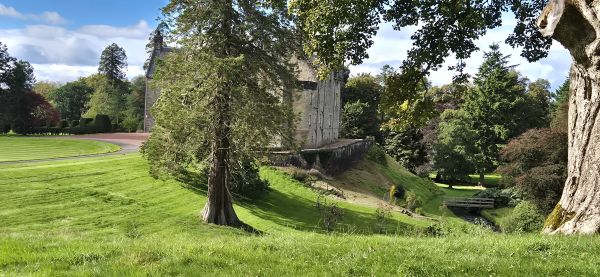Walk left from parked cars up the drive until a small cutting to the left of the drive. This emerges onto a stony drive leading to a woodshed. Walk past the shed and take a rough track right ascending into woodland. Cross to the left to find a path next to a fence. Proceed through Pirlie Hill Wood where the ground is sometimes uneven. Watch out for tree roots and thick vegetation.
Turn right towards the opposite side of the wooded area and follow this through heavy grass growth towards a wooden gate opening onto a tarmac lane. Turn left into the lane and walk past Pant Wood. Turn right onto a paved road past Wyndford. We will take a tea break in a sheltered spot off this road, then emerge down a steep hill to the former Stair Inn. Branch right onto the B703, towards the village of Stair, and continue road-walking over the bridge towards houses. At Yett we will take a right turn up the road towards a garden centre passing fields of young cows, then take the next right onto Daldorch Road. Again we turn right at a wind farm down a steep lane towards the river. We will cross a stile into a field on the left & track through heavy grass to another stile onto the south bank of the River Ayr, turning left onto the path and following its waymarks for half a mile.
There are muddy areas to cross leading to a choice between steep steps down to the river, ascending another flight of steep steps, or keeping to the top (shorter) path to meet the second set of steps as it rejoins the top of this deep ravine.
We cross the B743 to climb to see the monument, then rejoin the B743 turning left to walk back to Stairaird and the parked cars.
There is the chance of seeing otters, woodpeckers and herons along this Woodlands Nature Reserve. Descending down a steep path, there is the opportunity to stand beside a flight of sandstone steps carved into the cliff face, where the congregation stood to hear 17th century Covenanter Alexander Peden preach from the opposite bank. He was dodging arrest as he refused to accept Charles II’s authority over the Church. He evaded arrest several times, and escaped more than once by boat to Ireland, but always returned to Scotland and is buried at his brother’s farm in Auchinleck. The walk also takes in a memorial to Mary Campbell, one of Robert Burns’ amours. He wrote about their brief liaison in the poem “Highland Mary”.


